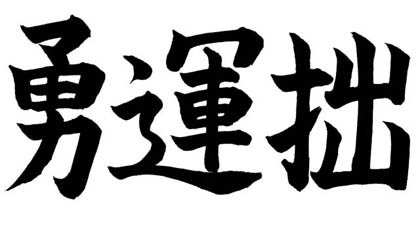Happy new year 2011
 The Brussels Yaegaki-Kai wish you all a happy new year 2011 – Akemashite omedeto gozaimasu – May the year of the Rabbit (Usagi – 兎) bring you good health, happiness and success. For all of us budō addicts we wish you a lot of intensive Renshu followed by relaxing dai ni dojo “second dojo” sessions, make a lot of new friends through practice and have fun in your day to day life.
The Brussels Yaegaki-Kai wish you all a happy new year 2011 – Akemashite omedeto gozaimasu – May the year of the Rabbit (Usagi – 兎) bring you good health, happiness and success. For all of us budō addicts we wish you a lot of intensive Renshu followed by relaxing dai ni dojo “second dojo” sessions, make a lot of new friends through practice and have fun in your day to day life.
In addition to our best wishes for 2011, here is a non-exhaustive list of the main things you have to do in Japan to decently celebrate a happy new year: Bōnenkai (忘年会), Kadomatsu (門松), Kagami mochi (鏡餅), (O)Zōni (雑煮), Osechi-ryōri (御節料理), Hatsuhinode (初日の出), Hatsumōde, Keiko-hajime (稽古始め), Shinnenkai (新年会) and many others. Follow the “Read more” link for more detail …
Bōnenkai (忘年会)
 A bōnenkai literally “forget the year gathering” is a Japanese drinking party that takes place at the end of the year, and is generally held among groups of co-workers or friends. The purpose of the party, as its name implies, is to forget the woes and troubles of the past year, usually by consumption of large amounts of alcohol, yeaahh …
A bōnenkai literally “forget the year gathering” is a Japanese drinking party that takes place at the end of the year, and is generally held among groups of co-workers or friends. The purpose of the party, as its name implies, is to forget the woes and troubles of the past year, usually by consumption of large amounts of alcohol, yeaahh …
Kadomatsu (門松)
 A kadomatsu literally “gate pine” is a traditional Japanese decoration of the New Year placed in pairs in front of homes supposedly to welcome ancestral spirits or kami of the harvest. They are placed after Christmas until January 7 and are considered temporary housing for kami.
A kadomatsu literally “gate pine” is a traditional Japanese decoration of the New Year placed in pairs in front of homes supposedly to welcome ancestral spirits or kami of the harvest. They are placed after Christmas until January 7 and are considered temporary housing for kami.
Mochitsuki – Kagami mochi (鏡餅)
 The traditional mochi-pounding ceremony in Japan is Mochitsuki.
The traditional mochi-pounding ceremony in Japan is Mochitsuki.
Kagami mochi literally mirror rice cake, is a traditional Japanese New Year decoration. It usually consists of two round mochi (rice cakes), the smaller placed atop the larger, and a daidai (a Japanese bitter orange) with an attached leaf on top. The two mochi discs are variously said to symbolize the going and coming years, the human heart, “yin” and “yang”, or the moon and the sun. The “daidai”, whose name means “generations”, is said to symbolize the continuation of a family from generation to generation.
Osechi-ryōri (御節料理)
 Osechi-ryōri are traditional Japanese New Year foods. The tradition started in the Heian Period (794-1185). Osechi are easily recognizable by their special boxes called jūbako (重箱), which resemble bentō boxes. Like bentō boxes, jūbako are often kept stacked before and after use.
Osechi-ryōri are traditional Japanese New Year foods. The tradition started in the Heian Period (794-1185). Osechi are easily recognizable by their special boxes called jūbako (重箱), which resemble bentō boxes. Like bentō boxes, jūbako are often kept stacked before and after use.
(O-)Zōni (雑煮)
 Zōni often with the honorific “o-” as o-zōni, is a Japanese soup containing mochi rice cakes. The dish is strongly associated with the Japanese New Year and its tradition of osechi ceremonial foods.
Zōni often with the honorific “o-” as o-zōni, is a Japanese soup containing mochi rice cakes. The dish is strongly associated with the Japanese New Year and its tradition of osechi ceremonial foods.
Hatsuhinode (初日の出)
 Hatsuhinode is the first sunrise of the year. Before sunrise on January 1, people often drive to the coast or climb a mountain so that they can see the first sunrise of the new year.
Hatsuhinode is the first sunrise of the year. Before sunrise on January 1, people often drive to the coast or climb a mountain so that they can see the first sunrise of the new year.
Hatsumōde
 Hatsumōde is the first trip to a shrine or temple. Many people visit a shrine after midnight on December 31 or sometime during the day on January 1. As you can see the shrines are really overcrowded and reaching the honden (本殿) main building of the famous one is a real obstacle course.
Hatsumōde is the first trip to a shrine or temple. Many people visit a shrine after midnight on December 31 or sometime during the day on January 1. As you can see the shrines are really overcrowded and reaching the honden (本殿) main building of the famous one is a real obstacle course.
Keiko-hajime (稽古始め)
Keiko-hajime is the first practice of the new year. Photo coming soon …
Toshikoshi-keiko (年越し稽古)
Toshikoshi-keiko is training over midnight on the New Year’s eve.
Shinnenkai (新年会)
 A shinnenkai literally “new year gathering” is the Japanese tradition of welcoming the arrival of the New Year, usually by the drinking of alcohol. A shinnenkai is generally held among co-workers or friends in January.
A shinnenkai literally “new year gathering” is the Japanese tradition of welcoming the arrival of the New Year, usually by the drinking of alcohol. A shinnenkai is generally held among co-workers or friends in January.
So one more time to everybody: “Akemashite omedeto gozaimasu !!!”



